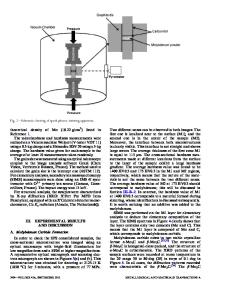Densification and Sintering of a Microwave-Plasma-Synthesized Iron Nanopowder
- PDF / 280,145 Bytes
- 6 Pages / 612 x 792 pts (letter) Page_size
- 117 Downloads / 397 Views
I7.7.1
Densification and Sintering of a Microwave-Plasma-Synthesized Iron Nanopowder L. J. Kecskes, R. H. Woodman, and B. R. Klotz U.S. Army Research Laboratory, Weapons and Materials Research Directorate Aberdeen Proving Ground, MD 21005-5069, USA ABSTRACT Powder compacts made from microwave-plasma-synthesized iron (Fe) nanopowder (Materials Modification Inc., Fairfax, VA) were sintered under hydrogen (H2). Results showed that without the application of pressure, the powder could not be sintered to full density. In subsequent experiments, the powder was consolidated to final densities near 80% of the theoretical full density, using plasma pressure compaction (P2C). To provide an explanation for the difficulty in attaining full densification, the precursor powder and compacted pellet characteristics were examined by several methods. These included residual porosity by mercury pycnometry, surface area measurement by Brunauer, Emmett, and Teller (BET) analysis, and structural change by xray diffraction (XRD) and scanning electron microscopy (SEM). It was observed that the nanosized primary particles were aggregated into micrometer-sized dendritic structures, with the appearance of tumbleweeds. The observed limitations in the densification and associated porous microstructures of the pressureless-sintered and P2C-densified compacts were rationalized in terms of the behavior of the dendritic aggregate structures rather than that of the nanosized primary particles. INTRODUCTION A widely accepted method for preparation of full-density nanograined material entails comminution of micrometer-sized powder to nanoscale by high-energy ball milling followed by sinter forging [1]. However, the fabrication of large, fully dense nanostructured metal bodies remains an unrealized goal. A promising alternative to comminution is the direct synthesis of the nanopowder by microwave plasma synthesis (MPS). Iron (Fe) bodies of 95% theoretical density (TD) have been reported by moderate-pressure consolidation of precursor powder by plasma pressure compaction (P2C) at 850 oC [2]. The mean particle size of the precursor was measured to be ~500 nm, the grain size of the final part was on the order of 10 µm. The primary advantage of P2C, also known as plasma activated sintering (PAS), is the ability to apply large DC or AC currents through a powder sample, causing the formation of a plasma arc, whereby the interior temperatures rise rapidly. The plasma causes the evolution of impurities, and a simultaneous application of moderate pressure densifies the sample material. Detailed descriptions of PAS can be found in several references [3,4]. A representative lot of MPS Fe nanopowder was obtained from Materials Modification Inc., Fairfax, VA. Fe nanopowder green compacts were pressureless sintered in a hydrogen (H2) atmosphere with the objective of relating the precursor characteristics and properties to its sintering behavior. Results showed that without pressure, there was difficulty in attaining full density samples. Subsequently, several attem
Data Loading...











